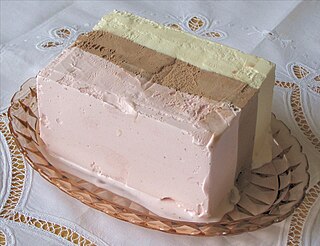
Neapolitan ice cream, also sometimes referred to as Harlequin ice cream, is an ice cream composed of three separate flavors arranged side by side in the same container, usually without any barrier between them.

Frumenty was a popular dish in Western European medieval cuisine. It is a porridge, a thick boiled grain dish—hence its name, which derives from the Latin word frumentum, "grain". It was usually made with cracked wheat boiled with either milk or broth and was a peasant staple. More luxurious recipes include eggs, almonds, currants, sugar, saffron and orange flower water. Frumenty was served with meat as a pottage, traditionally with venison or even porpoise. It was also frequently used as a subtlety, a dish between courses at a banquet.

Ice cream is a frozen dessert typically made from milk or cream that has been flavoured with a sweetener, either sugar or an alternative, and a spice, such as cocoa or vanilla, or with fruit, such as strawberries or peaches. Food colouring is sometimes added in addition to stabilizers. The mixture is cooled below the freezing point of water and stirred to incorporate air spaces and prevent detectable ice crystals from forming. It can also be made by whisking a flavoured cream base and liquid nitrogen together. The result is a smooth, semi-solid foam that is solid at very low temperatures. It becomes more malleable as its temperature increases.
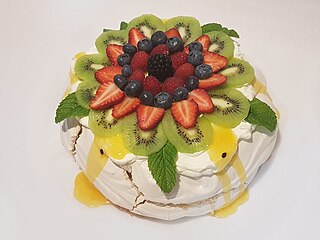
Pavlova is a meringue-based dessert. Originating in either Australia or New Zealand in the early 20th century, it was named after the Russian ballerina Anna Pavlova. Taking the form of a cake-like circular block of baked meringue, pavlova has a crisp crust and soft, light inside. The confection is usually topped with fruit and whipped cream. The name is commonly pronounced pav-LOH-və or pahv-LOH-və, and occasionally closer to the name of the dancer, as PAHV-lə-və.

A pie is a baked dish which is usually made of a pastry dough casing that contains a filling of various sweet or savoury ingredients. Sweet pies may be filled with fruit, nuts, fruit preserves, brown sugar, sweetened vegetables, or with thicker fillings based on eggs and dairy. Savoury pies may be filled with meat, eggs and cheese or a mixture of meat and vegetables.
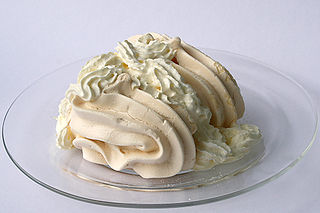
Meringue is a type of dessert or candy, of French origin, traditionally made from whipped egg whites and sugar, and occasionally an acidic ingredient such as lemon, vinegar, or cream of tartar. A binding agent such as salt, flour or gelatin may also be added to the eggs. The key to the formation of a good meringue is the formation of stiff peaks by denaturing the protein ovalbumin via mechanical shear.
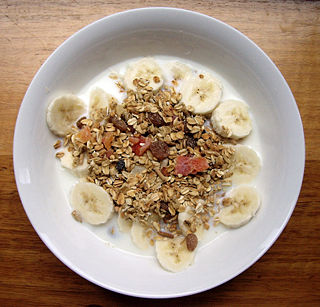
Muesli is a cold Swiss breakfast dish, the primary ingredient of which is rolled oats. Traditionally, it is set to soak overnight and eaten the next morning. Additional ingredients, such as grains, nuts, seeds, and fresh or dried fruits are sometimes added, along with milk or cream, a small amount of citrus juice, and honey to add sweetness. Yoghurt, other milk products, or milk substitutes are now commonly added to both homemade and commercially packaged muesli recipes.

Cranachan is a traditional Scottish dessert. It was originally a celebration of harvest, made following the raspberry harvest in August. The dessert of cream and fresh seasonal raspberries is bolstered by Scottish oats and whisky. It has been called 'the uncontested king of Scottish desserts'. Cranachan owes its origins to crowdie, a popular breakfast in which crowdie cheese is combined with lightly toasted oatmeal, cream, and local honey. Raspberries, when in season, might be added to the dish.

Queen of Puddings is a traditional British dessert, consisting of a baked, breadcrumb-thickened egg mixture, spread with jam and topped with meringue. Similar recipes are called Monmouth Pudding and Manchester Pudding.

Heston Marc Blumenthal is an English celebrity chef, TV personality and food writer. His restaurants include the Fat Duck in Bray, Berkshire, a three-Michelin-star restaurant that was named the world's best by the World's 50 Best Restaurants in 2005.

Banana pudding is a pudding generally consisting of layers of sweet vanilla flavored custard, vanilla wafers and/or ladyfingers and sliced fresh bananas placed in a dish and served, topped with whipped cream or meringue.

A fool is an English dessert. Traditionally, fruit fool is made by folding puréed stewed fruit into sweet custard. Modern fool recipes often use whipped cream instead of custard. Additionally, a flavouring such as rose water may be added.

Ambrosia is an American variety of fruit salad originating in the Southern United States. Most ambrosia recipes contain canned or fresh pineapple, canned mandarin orange slices or fresh orange sections, miniature marshmallows, and coconut. Other ingredients might include various fruits and nuts: maraschino cherries, bananas, strawberries, peeled grapes, or crushed pecans. Ambrosia can also include mayonnaise or dairy ingredients: whipped cream, sour cream, cream cheese, pudding, yogurt, or cottage cheese.

A lemon tart is a dessert dish, a variety of tart. It has a pastry shell with a lemon flavored filling.

Parfait is either of two types of dessert. In France, where the dish originated, parfait is made by boiling cream, egg, sugar and syrup to create a custard-like or meringue-like puree which is then frozen. The American version consists of layers differentiated by the inclusion of such ingredients as granola, nuts, yogurt and liqueurs, topped off with fruits or whipped cream.

Crab ice cream is a sweet flavour of ice cream with crab. It is offered in some food establishments, particularly ice cream parlours, such as Heston Blumenthal's The Fat Duck restaurant, and the Venezuelan Coromoto.
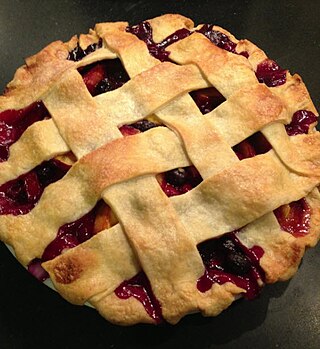
Pie in American cuisine has roots in English cuisine and has evolved over centuries to adapt to American cultural tastes and ingredients. The creation of flaky pie crust shortened with lard is credited to American innovation.

















